[Trade Journal]
Publication: Telephony
Chicago, IL, United States
vol. 5, no. 6, p. 372-375, col. 1-2
THE PEIRCE PATENTED CONSTRUCTION
SPECIALTIES.
The many objections to the use of wood brackets on brick or stone walls are conceded by everybody. It is a difficult job to put them up and requires considerable time. The chances are that they will not stay up for any length of time, or, at any rate, they arc easily twisted out of shape and many troublesome cases result. Should an occasional hold on securely it cannot easily be taken down if it is desired to discontinue the service. Their appearance also is very much against them.
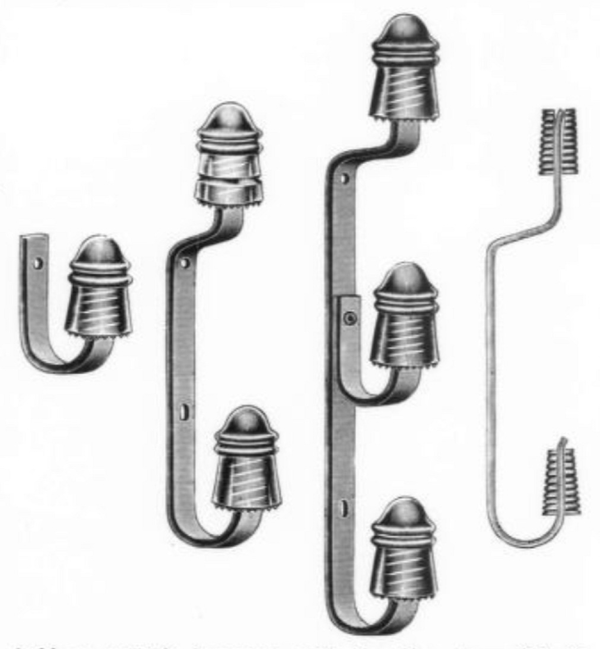 |
Almost the same objections apply to all common iron brackets; besides their extra cost must be considered also the fact that they are liable to break the insulators or will not hold the insulators securely.
This condition of things led to the invention of the Peirce patented steel brackets and anchor bolts and the Peirce hammer drill.
The Peirce bracket embodies the only inexpensive and efficient method of attaching a glass insulator to a piece of bar steel.
The bracket is made of 1-1/4" x 1" Bessemer steel, galvanized. The ends of the bar are slightly bent and act as wedges to spread the split pins when the same are drawn upward by screwing the insulator on.
It is claimed that they are cheaper in "first cost" than other metal brackets, and cheaper than wood brackets if cost of labor of installing them is considered. The maintenance expense is entirely eliminated. Their strength and durability are also urged as points in their favor. Insulators will not be broken by expansion of the metal, nor by screwing the same on too tightly.
The Peirce galvanized steel anchor bolts have been especially designed for fastening the Peirce bracket to brick or stone walls, but, of course. may be used for any number of purposes, such as fastening to brick walls, telephones. porcelain knobs, glass knobs, etc., etc.
Much less time is required to install them; they will stand a much heavier strain, require smaller holes and make firmer and more secure fastenings than other expansion bolts. They cannot turn in the holes and positively cannot pull out.
A Peirce anchor bolt can be installed in less than one minute with the aid of a Peirce hammer drill.
 |
 |
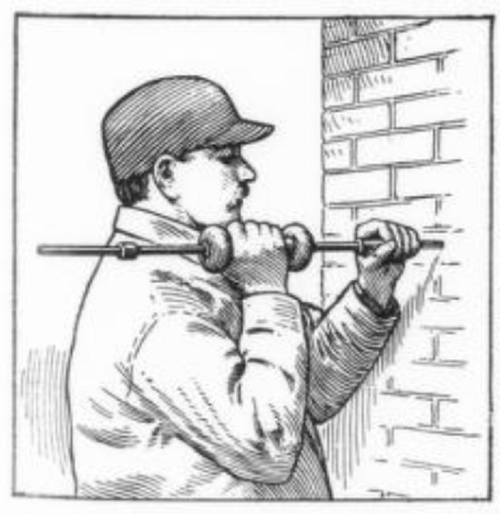 |
The Peirce hammer drill is recommended for drilling holes quickly in brick or stone walls. It is claimed that this tool has no equal, for the reason that every blow struck with the sliding hammer counts for all it is worth, and it is worth more than a half dozen blows with an ordinary hamŽmer and drill. Each blow must be struck squarely, and as the hammer strikes near the drill point, the full benefit of the same is obtained. It will he noticed by the two illustrations that one end of the drill consists of a chuck and drill for boring, while the other end is a hollow punch used for expanding the lead sleeve on the bolt. In an ordinary brick wall a hole from 3/4" to 1" deep should be made with the hammer drill. The anchor bolt is then inserted head first, and by using the punch end of the hammer drill the lead sleeve is forced back over the expansive head and into every Cr. vice of the brick or stone. About three or four blows art' necessary to expand the lead sleeve, and the bolt is ready for use. This can all be accomplished in less time than it takes to tell about it.
The more strain put upon the bolt the more it tends to expand the lead sleeve and the tighter it becomes.
The hammer drill is also perfectly adapted for use with long drills for boring through walls.
Peirce underhanging brackets are used for temporarily or permanently doubling the capacity of a cross-arm. The use of this device does not weaken the cross-arm with bolt holes. They are adjustable for any size arm; are easily put up and afford the best of insulation.
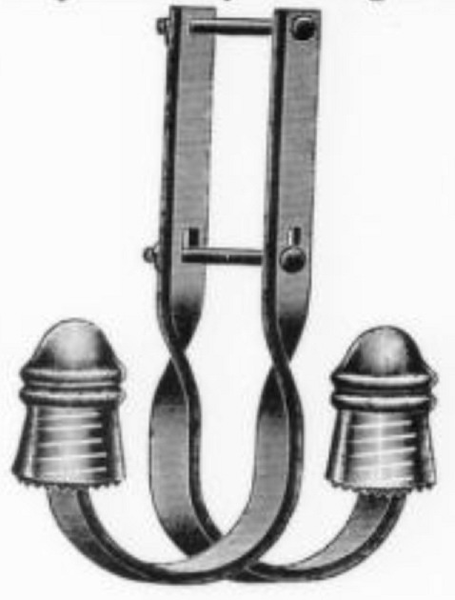 |
These brackets are used principally for temporary work, and the ease with which they may be put up or taken down recommends them for this purpose.
Peirce break arms are used for breaking a through wire for a series drop; for dropping from the end of a route arm or for a transposition. They are as easily put up as the underhang brackets, no extra tools being required. They do not weaken the arm with bolt holes and are adjustable to any size arm. When used to drop from the end of an arm they leave the end route pin available; whereas common arms use this space. The same method of fastening the insulators is used with the break arms and underhanging brackets as with the brackets.
By using the Peirce patented brackets angle iron crossarms are made up at a price that will compare favorably with common wood arms.
The following are some of the advantages claimed for angle iron cross-arms:
They will outlast wood arms; are stronger and afford more substantial construction. Their neat appearance is in their favor. They occupy less space on the pole and greatly lessen the danger to the pole from wind and sleet storms. They do not afford a landing for ice and snow and reduce trouble cases from this cause to the minimum. Few trouble cases will occur on a line equipped with angle arms, as there are no pins to break and the insulators cannot pull off; but when trouble does occur it is a positive case and is easily located.
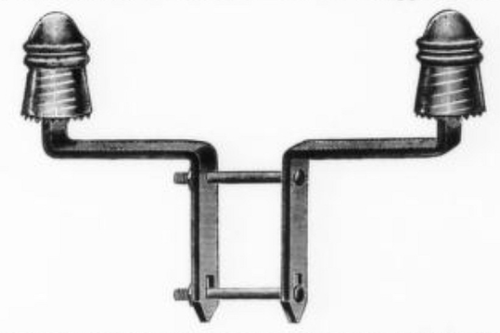 |
 |
Circle pole-top block distribution, with Peirce distributing circles and pole houses, are for exchanges in good-sized cities, especially in business sections where the buildings face all sides of the block, this kind of a system is highly recommended as efficient, substantial and most ecoŽnomical from a construction and maintenance standpoint.
A pole set near the center of the block is equipped with a distributing circle and pole house, and is fed with either an underground or aerial cable. From this one pole the rear of every building in the block can generally be reached with a straight drop. for which twisted pairs of rubber-covered wires are used.
This system is less expensive than a complete underground installation, and from a maintenance standpoint if is preferable, as the iron pipe laterals and pump-log runs under sidewalks (the bugbears of an underground system) are eliminated.
The advantages of the system over an open wire aerial distribution are too manifest to require mentioning.
The system commends itself on account of its simplicity; as well as its neat and substantial appearance.
Peirce pole-top distributing circle is 41 inches in diameter and is made of galvanized steel 1-1/2" x 1". Horizontal braces of the same material are riveted to the rim and the diagonal braces are furnished for bolting to the horizontal braces at a point near their outer end. The excellent manner of bracing the rim will noticed by referring to the cut. The manner of fastening the diagonal braces prevents any twisting and is considered an important advantage over the old way of bracing circle tops.
 |
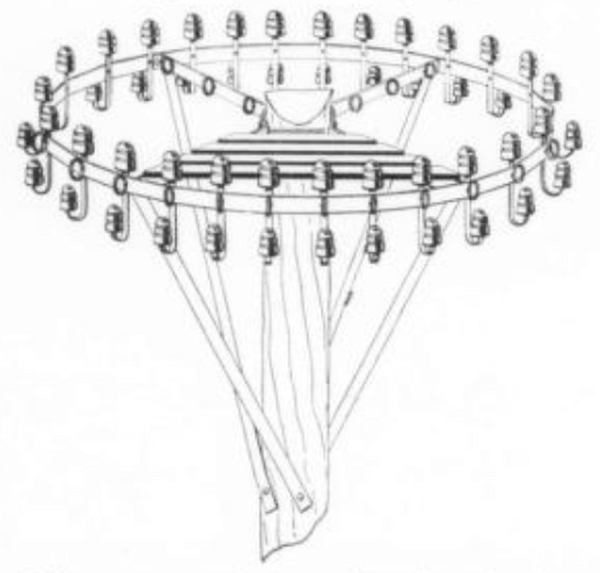 |
Peirce patented brackets, twenty-five in number, are riveted in slight angles in the rim about five inches apart. Single brackets are used in the twenty-five pair distributer, and double brackets in the fifty-pair.
The distributing circle is secured to the pole by ordinary machine or lag bolts.
Jumper wire rings arc provided at the base of each pin on the outside of the rim and along two of the horizontal braces.
One quarter-section of the circle is furnished with a seat, as shown in illustration, front which every part of the circle may be reached. There is ample room between the braces and between the rim and pole to allow a man to get through the distributer.
With each distributing circle a Peirce pole house is recommended for mounting above the distributing circle, with the door opening directly above the pole top and facing the seat on the distributer so that the lineman may easily reach any part of his work without changing his position.
 |
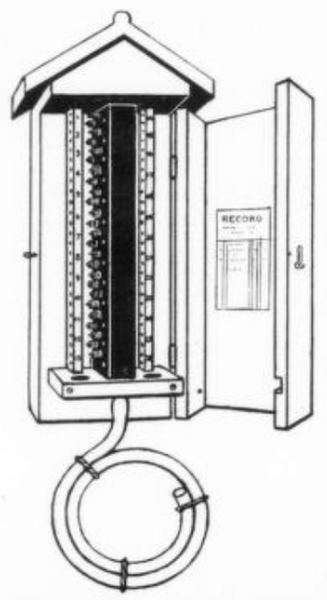 |
Description.The pole house is made of clear cypress, painted white inside and outside. The sides and front form the door, which is hinged to the back, and when opened allows free access to all wires and connections. The terminal head is made of iron, front and back, with fiber sides.
Binding posts, to which the cable conductors are soldered on the inside, are mounted upon the outer surfaces of the fiber pass through holes in the inner frame and are screwed onto the binding nuts and afford firm and secure connections for the jumper wires. The fuses are held firmly in a horizontal position by the frame. This inner frame with a glass front completely incloses the terminal head, which is itself absolutely water and air tight and is filled with cable compound.
Each conductor terminal is numbered on the edge of the inner frame. The fuses arc very easily taken out or replaced.
Peirce pole houses are always furnished complete with a short piece of cable attached and with all wiring done. The terminal head is filled with cable compound and is completed at the factory. The head is sealed at the top with a screw plug. The cable sheath is secured by a wiped joint to the lower end of the head.
To install a Peirce pole house it is only necessary to splice the line cable to the short piece of cable furnished with the house. The jumper wires arc to he brought down through the sides of the box to the jumper wire rings on the cross braces of the distributing circle, and then distributed to the insulators through the rings around the circle.
The following advantages are claimed for these pole houses and terminal heads:
They are very small and light and very easily installed. The wiring and. filling is done and it is only necessary to splice the line cable to the end of the short piece of cable with the pole house. They are great time savers, to distribute from, to test from, as well as to install. They afford the best protection. Furnished fused or not fused. Fused terminal heads are recommended where distribution is made to aerial lines, but are not considered necessary when only short rubber-covered drop wires are used.
The house described above is for use with paper cable only, although it is not necessarily used with a distributing circle. It is perfectly adapted for use as an ordinary terminal head for distributing on the side-of a pole to cross-arms.
The Illinois Electric Company, Chicago, are general sales agents and will be glad to furnish more complete information. prices. etc., upon request.
